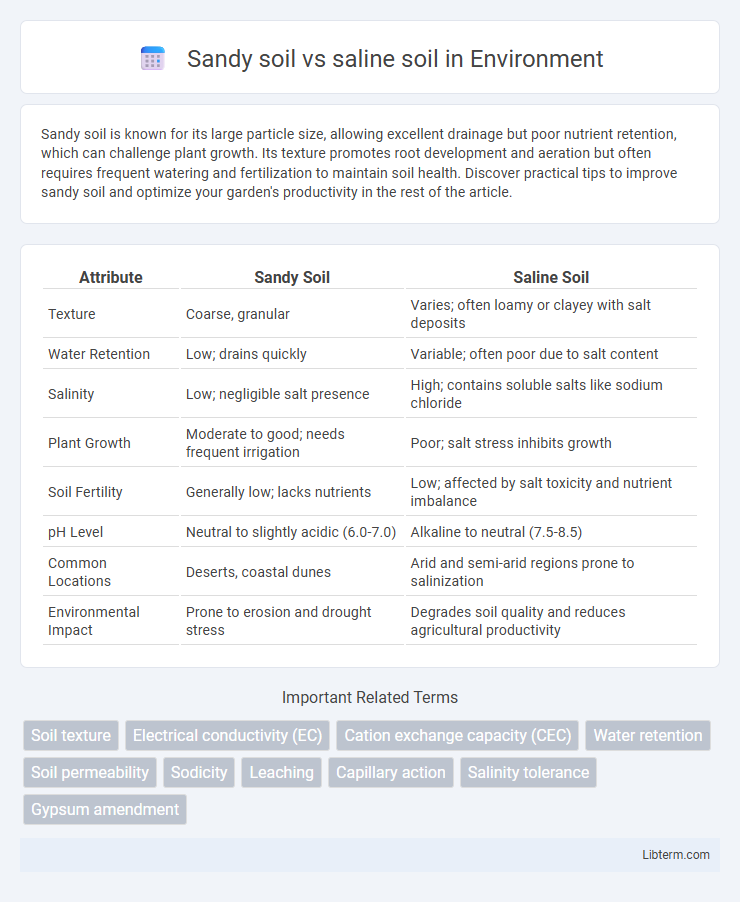Sandy soil is known for its large particle size, allowing excellent drainage but poor nutrient retention, which can challenge plant growth. Its texture promotes root development and aeration but often requires frequent watering and fertilization to maintain soil health. Discover practical tips to improve sandy soil and optimize your garden's productivity in the rest of the article.
Table of Comparison
| Attribute | Sandy Soil | Saline Soil |
|---|---|---|
| Texture | Coarse, granular | Varies; often loamy or clayey with salt deposits |
| Water Retention | Low; drains quickly | Variable; often poor due to salt content |
| Salinity | Low; negligible salt presence | High; contains soluble salts like sodium chloride |
| Plant Growth | Moderate to good; needs frequent irrigation | Poor; salt stress inhibits growth |
| Soil Fertility | Generally low; lacks nutrients | Low; affected by salt toxicity and nutrient imbalance |
| pH Level | Neutral to slightly acidic (6.0-7.0) | Alkaline to neutral (7.5-8.5) |
| Common Locations | Deserts, coastal dunes | Arid and semi-arid regions prone to salinization |
| Environmental Impact | Prone to erosion and drought stress | Degrades soil quality and reduces agricultural productivity |
Introduction to Sandy and Saline Soils
Sandy soil consists of large, coarse particles that allow rapid water drainage and low nutrient retention, making it ideal for certain crops but challenging for moisture-dependent plants. Saline soil contains high concentrations of soluble salts, which can inhibit plant growth by disrupting water uptake and causing ion toxicity. Understanding the physical and chemical properties of these soils is crucial for effective soil management and agricultural productivity.
Key Characteristics of Sandy Soil
Sandy soil features large particles and high permeability, allowing for rapid drainage and low water retention, which makes it prone to nutrient leaching. Its coarse texture results in poor nutrient content and low organic matter, necessitating frequent fertilization for optimal plant growth. Sandy soil warms quickly in spring, promoting early root development but requiring careful irrigation management to maintain moisture levels.
Key Characteristics of Saline Soil
Saline soil is characterized by high concentrations of soluble salts such as sodium chloride, calcium chloride, and magnesium sulfate, which affect soil structure and plant growth. It exhibits poor water infiltration and retention due to osmotic stress, leading to reduced availability of water to plants and increased plant stress. Unlike sandy soil, saline soil often has a white crust on the surface and requires specialized management practices to mitigate salinity and restore soil health.
Comparative Soil Texture and Structure
Sandy soil features coarse particles ranging from 0.05 to 2 mm, promoting excellent drainage and aeration but low nutrient retention due to large pore spaces. Saline soil, often characterized by finer textures such as silty or clayey particles combined with high soluble salt content, exhibits poor structure with reduced permeability and water infiltration. The contrasting particle size and salt-induced dispersion affect root growth and microbial activity, making sandy soils more favorable for crop cultivation compared to saline soils that require remediation for productivity improvement.
Water Retention: Sandy vs Saline Soils
Sandy soil has large particles and pores, leading to low water retention and rapid drainage, which can limit moisture availability for plants. In contrast, saline soil contains high concentrations of soluble salts that affect water uptake by plants despite potentially higher water-holding capacity. Understanding the water retention differences between sandy and saline soils is critical for effective irrigation and crop management strategies.
Nutrient Availability and Fertility
Sandy soil has large particles and low organic matter, leading to poor nutrient retention and rapid leaching of essential minerals like nitrogen, potassium, and phosphorus, which reduces its fertility. Saline soil contains high concentrations of soluble salts that disrupt nutrient uptake by plants, causing nutrient imbalances and toxicity that further degrade soil fertility. Effective management practices such as organic amendments for sandy soil and leaching or gypsum application for saline soil are critical to improving nutrient availability and sustaining agricultural productivity.
Impact on Plant Growth
Sandy soil, characterized by large particles and high drainage, often results in rapid nutrient leaching, which can limit water and nutrient availability essential for optimal plant growth. Saline soil contains elevated concentrations of soluble salts, causing osmotic stress that impairs water uptake and can lead to ion toxicity in plants, significantly reducing crop yield and biomass. Both soil types challenge root development and nutrient absorption, necessitating tailored management practices such as soil amendment and salt leaching to improve plant growth outcomes.
Management Practices for Sandy Soils
Sandy soil management practices emphasize improving water retention and nutrient availability through organic matter incorporation, mulching, and frequent irrigation. Applying soil amendments such as compost or biochar enhances the soil structure and microbial activity, while careful fertilizer scheduling reduces nutrient leaching. Crop rotation with deep-rooted plants also helps stabilize the soil and maintain fertility in sandy soils.
Management Practices for Saline Soils
Management practices for saline soils emphasize proper drainage systems to prevent salt accumulation by facilitating leaching through excess water flow. Incorporating organic matter improves soil structure and enhances microbial activity, increasing salt tolerance in plants. Selecting salt-tolerant crop varieties and applying gypsum or other soil amendments help displace sodium ions and restore soil fertility in saline environments.
Choosing Crops for Sandy and Saline Soils
Sandy soil requires crops that tolerate low water retention and nutrient-poor conditions, such as millet, maize, and peanuts, which are drought-resistant and adapt well to fast-draining substrates. Saline soil demands salt-tolerant crops like barley, sugar beet, and cotton, which can withstand high salinity levels and minimize yield loss. Selecting crop varieties with inherent tolerance to these soil characteristics is crucial for optimizing agricultural productivity and ensuring sustainable land use in affected regions.
Sandy soil Infographic

 libterm.com
libterm.com